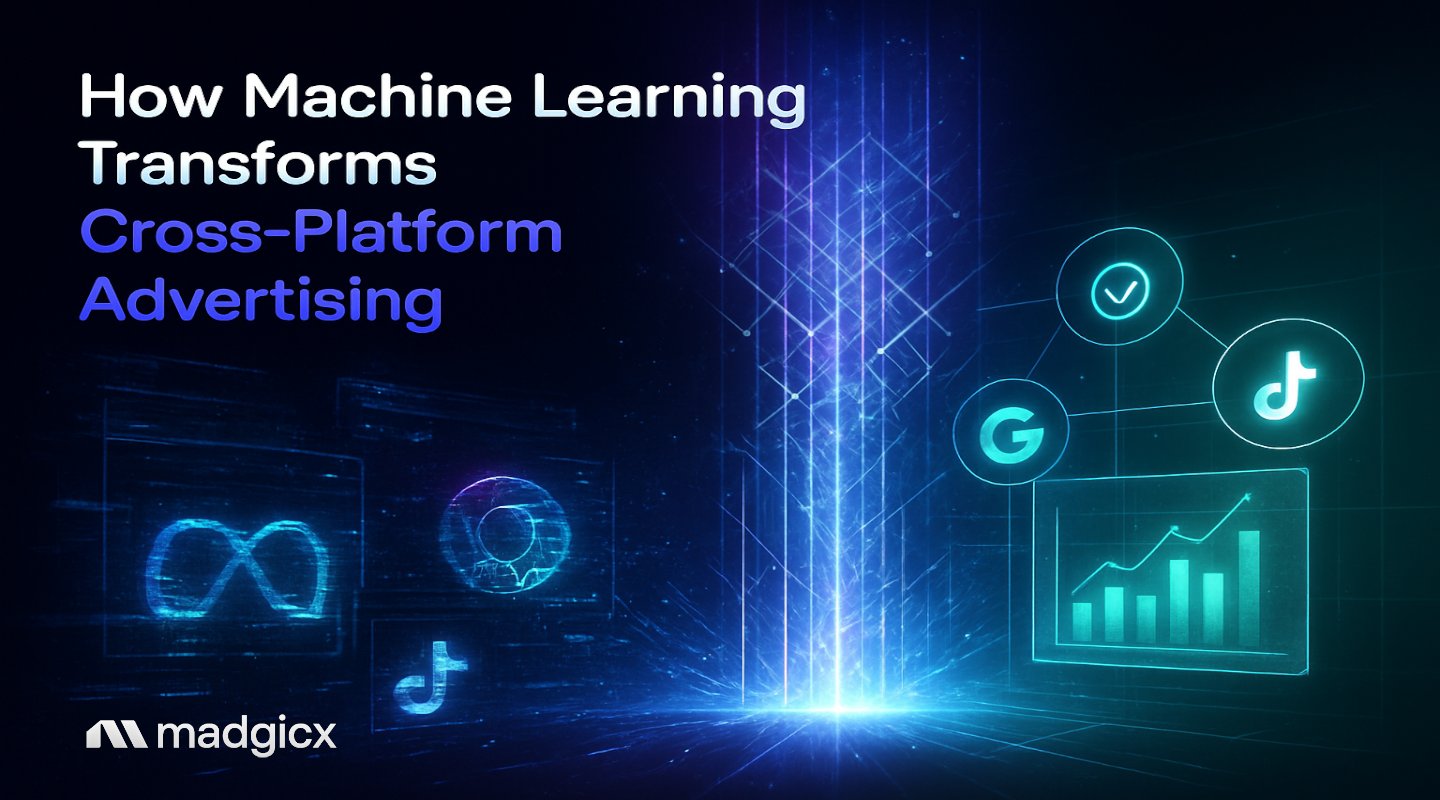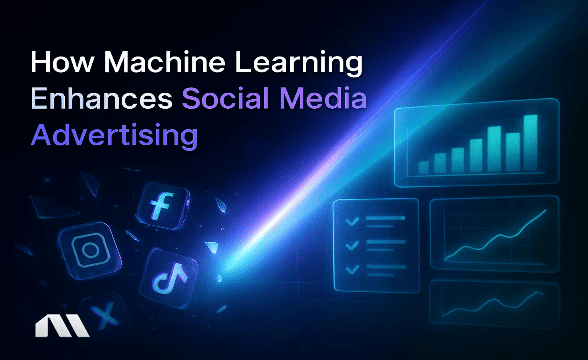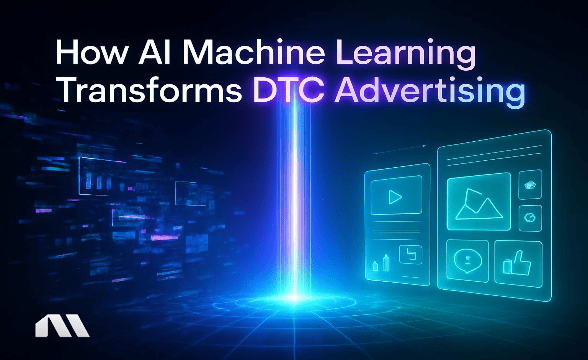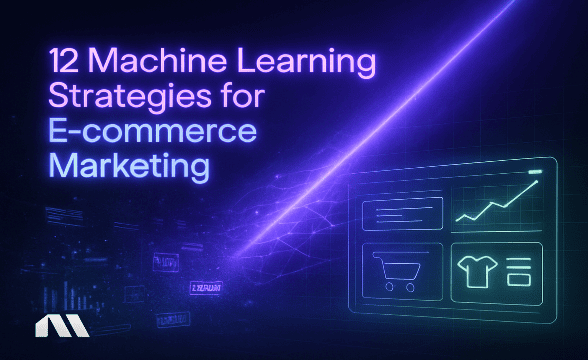Discover how machine learning transforms cross-platform advertising with AI-powered optimization, predictive targeting, and unified campaign management.
Picture this: It's 9 AM, and you're already drowning in browser tabs. Meta Ads Manager in one window, Google Ads in another, TikTok Ads Manager somewhere in the mix, and don't even get me started on the spreadsheet where you're trying to manually track which platform is actually driving conversions.
Sound familiar?
You're constantly switching between dashboards, making bid adjustments based on yesterday's data, and playing a never-ending guessing game with budget allocation. Meanwhile, your attribution is a mess, your audiences are siloed, and you're pretty sure you're leaving money on the table – you just can't figure out where.
Here's the thing: Machine learning for cross-platform advertising uses AI algorithms to optimize ad campaigns across multiple social media platforms by analyzing performance data, predicting user behavior, and dynamically adjusting targeting, bidding, and delivery strategies. This allows marketers to increase efficiency and scale campaigns without relying solely on manual management.
The performance marketers who leverage this approach aren't just saving time — they're fundamentally changing how their campaigns operate.
What You'll Learn
- How ML unifies data from multiple advertising platforms for smarter optimization decisions
- Specific techniques for predictive audience targeting and AI-assisted bidding coordination
- Implementation framework for setting up cross-platform ML optimization
- Bonus: ROI calculation methodology and performance benchmarking strategies
What Is Machine Learning for Cross-Platform Advertising?
Let's clear up some confusion first. Cross-platform advertising isn't just running ads on Facebook AND Google (that's multi-channel marketing). True cross-platform advertising means your campaigns work together as a coordinated system, sharing insights and optimizing collectively rather than competing against each other.
- Machine learning for cross-platform advertising transforms this coordination from impossible to streamlined through three core capabilities:
- Unified Data Analysis: ML algorithms consolidate performance data from multiple platforms to identify patterns you'd never spot manually. Instead of seeing Facebook's 2.3% CTR and Google's 1.8% CTR as separate metrics, ML recognizes that users who see your Facebook ad first are 40% more likely to convert on Google.
- Predictive Targeting: These algorithms predict conversion probability across different audiences and platforms. They might discover that your lookalike audiences perform best on Meta for initial awareness, but similar users convert better on Google when they're ready to purchase.
- AI-Assisted Optimization: Real-time recommendations for bidding, budgets, and creative delivery happen faster than manual analysis allows. When ML detects that TikTok users are converting 23% better on weekends, it provides automated recommendations for budget allocation before you even notice the trend.
Here's what's driving this shift: 88% of digital marketers now use AI in daily tasks, with cross-platform optimization being a top priority. The manual approach simply can't keep up with the complexity of modern advertising ecosystems.
Pro Tip: Cross-platform differs from multi-channel by focusing on coordinated optimization rather than just presence across platforms. Think orchestra conductor, not solo performances.
How Machine Learning Powers Cross-Platform Success
Now let's get into the mechanics of how ML actually makes this magic happen. It's not just throwing AI at your campaigns and hoping for the best – there's sophisticated technology working behind the scenes.
Data Unification and Analysis
The foundation of everything starts with data. ML systems use API integrations to pull real-time performance data from every platform you're running ads on. But here's where it gets interesting: instead of just collecting data, these algorithms identify patterns across platforms and audience segments that reveal the true customer journey.
For example, ML might discover that users who engage with your Instagram Stories are 3x more likely to convert on a Google Search ad within 48 hours. That's not a correlation you'd spot checking dashboards manually, but it's exactly the kind of insight that transforms campaign performance.
Predictive Audience Targeting
Traditional lookalike audiences are platform-specific. ML-powered targeting creates unified customer profiles that work across all platforms. The algorithm analyzes behavioral patterns from your highest-value customers and identifies similar users regardless of where they spend time online.
This means your Facebook lookalike audience insights inform your Google Similar Audiences strategy, and your TikTok engagement data helps refine LinkedIn targeting. It's like having a customer intelligence system that follows your best prospects wherever they go online.
AI-Assisted Bidding and Budget Allocation
Here's where ML really flexes its muscles. Instead of setting static budgets and hoping for the best, algorithms provide real-time bid recommendations based on conversion probability across all platforms simultaneously.
When ML detects that Meta users are converting 15% better than usual on Tuesday afternoons, it doesn't just recommend increasing Meta bids – it analyzes whether those same users might be even more valuable on Google later in their journey, and provides coordinated strategy recommendations accordingly.
Attribution Modeling
Traditional attribution is broken for cross-platform campaigns. Last-click attribution gives all credit to the final touchpoint, while first-click ignores the nurturing process. ML-powered attribution models understand the true contribution of each platform throughout the customer journey.
This means you finally get accurate answers to questions like: "Should I increase my Facebook budget or my Google budget?" Because ML can tell you that Facebook drives awareness that leads to Google conversions, or that Google Search ads work best when supported by TikTok video campaigns.
The results speak for themselves: AI campaigns can deliver up to 14% higher conversion rates on average compared to traditional optimization methods. That's not a small improvement – that's the difference between profitable scaling and hitting performance walls.
For marketers looking to dive deeper into the technical aspects, our guide on machine learning algorithms for campaign optimization breaks down the specific models driving these improvements.
Quantified Performance Impact of Cross-Platform ML
Let's talk numbers, because that's what really matters in performance marketing. The impact of cross-platform ML optimization isn't theoretical – it's measurable, significant, and happening right now for advertisers who've made the switch.
Cost Efficiency Gains
The most immediate impact most advertisers see is in cost reduction. AI can reduce customer acquisition costs by up to 52% by identifying optimal audience segments that traditional targeting methods miss.
This happens because ML algorithms can spot micro-patterns in user behavior that indicate high conversion probability.
For example, instead of targeting broad demographics like "women 25-45 interested in fitness," ML might identify that "women who engage with fitness content on weekends and search for workout gear on mobile devices between 6-8 PM" convert at 3x the rate. That level of precision is impossible with manual optimization.
Google's own data shows that AI-powered bidding can reduce cost-per-acquisition by up to 30% through Smart Bidding strategies. But here's the kicker: when you combine Google's Smart Bidding with cross-platform audience insights from Meta and TikTok, those savings can compound even further.
Revenue and ROI Improvements
Cost reduction is great, but revenue growth is better. Companies investing deeply in AI can see 20–30% improvement in sales ROI, primarily through better cross-platform coordination and more accurate attribution modeling.
This improvement comes from two sources: finding better customers and optimizing the entire funnel. ML doesn't just help you acquire customers cheaper – it helps you find customers who spend more, stay longer, and refer others.
The automation aspect delivers its own ROI boost. Marketing automation can deliver ROI as high as 544%, with cross-platform automation being particularly effective because it eliminates the manual work of coordinating campaigns across multiple platforms.
Operational Efficiency
Beyond the direct performance improvements, there's the time savings factor. AI can reduce campaign setup time by up to 90% by streamlining audience creation, bid management, and creative optimization across platforms simultaneously.
Think about it: instead of spending 2 hours setting up campaigns on Meta, another hour on Google, and 30 minutes on TikTok, ML can help deploy coordinated campaigns across all three platforms in 15 minutes. That's not just time savings – that's up to 50% faster time-to-market for campaigns, which means you can capitalize on trends and opportunities before your competitors even notice them.
Real-World Example: Reddit's implementation of Graph Neural Networks delivered 2x better lift in predicted click-through rates, showing how advanced ML techniques can dramatically improve performance even for sophisticated platforms.
Pro Tip: Start with AI-assisted bidding across platforms before implementing advanced attribution modeling. The immediate cost savings will fund your investment in more sophisticated ML tools.
Implementation Framework for Cross-Platform ML
Alright, enough theory. Let's talk about how you actually implement this stuff without breaking your existing campaigns or your sanity. I've seen too many performance marketers try to go from zero to full automation overnight and end up worse off than when they started.
Phase 1: Data Foundation (Weeks 1-2)
Before any ML magic can happen, you need clean, connected data. This isn't the sexy part, but it's absolutely critical.
Connect Platform APIs: Start by ensuring all your advertising platforms can talk to each other. This means setting up proper API connections for Meta, Google, TikTok, and any other platforms you're running ads on. Most ML platforms, including Madgicx, handle this integration automatically, but you'll need admin access to all accounts.
Implement Unified Tracking: Deploy consistent UTM parameters and conversion tracking across all platforms. This is where many implementations fail – if your tracking isn't consistent, your ML algorithms will learn from garbage data and make garbage recommendations.
Set Up Data Quality Monitoring: Establish alerts for data discrepancies, missing conversions, or unusual performance patterns. ML algorithms are only as good as the data they're trained on, so data quality monitoring isn't optional.
Phase 2: Audience Intelligence (Weeks 3-4)
Once your data foundation is solid, you can start leveraging ML for smarter audience targeting.
Deploy Predictive Audience Modeling: Use ML algorithms to analyze your existing customer data and identify high-value audience segments across platforms. This goes beyond basic lookalike audiences to include behavioral prediction and cross-platform journey mapping.
Create Cross-Platform Lookalike Audiences: Instead of creating separate lookalike audiences on each platform, use unified customer data to create coordinated audience strategies. Your Facebook lookalike should complement your Google Similar Audience, not compete with it.
Implement Behavioral Targeting Algorithms: Set up ML systems to track user behavior patterns and predict optimal timing and platform for ad delivery. This is where you start seeing the real power of cross-platform coordination.
Phase 3: AI-Assisted Optimization (Weeks 5-6)
Now comes the fun part – letting ML handle the optimization recommendations that have been eating up your time.
Enable AI-Powered Bidding Strategies: Implement AI-assisted bidding across all platforms, with cross-platform coordination. This means your Meta campaigns and Google campaigns work together rather than bidding against each other for the same users.
Set Up Dynamic Budget Recommendations: Deploy algorithms that provide automated budget allocation suggestions based on real-time performance data. When TikTok is converting better, the system recommends more budget there. When Google Search picks up, budget recommendations follow.
Implement Real-Time Performance Monitoring: Establish automated alerts and optimization triggers that respond to performance changes faster than manual analysis allows. This includes automatic pause recommendations for underperforming ads and scaling suggestions for winning campaigns.
Platforms like Madgicx make this phase seamless by centralizing cross-platform data and applying AI-driven bidding and budget strategies automatically. Instead of juggling dashboards, you get unified performance insights and real-time optimization suggestions across Meta—all in one place. This drastically reduces manual workload while ensuring your budget flows toward the highest-impact opportunities.
Try Madgicx’s AI for free here.
Phase 4: Advanced Attribution (Weeks 7-8)
The final phase focuses on understanding and optimizing the complete customer journey across all platforms.
Deploy Multi-Touch Attribution Modeling: Implement ML-powered attribution that gives proper credit to each platform's role in the conversion process. This is crucial for accurate budget allocation and performance measurement.
Set Up Incrementality Testing: Use ML to run continuous incrementality tests that measure the true impact of each platform and campaign. This helps you understand which channels are actually driving new customers versus just capturing existing demand.
Create Unified Reporting Dashboards: Build comprehensive reporting that shows cross-platform performance, attribution insights, and optimization recommendations in a single view.
Platform-Specific Implementation Notes
Meta: Focus on Advantage+ campaigns combined with ML-powered creative optimization. Meta's native AI works best when fed high-quality audience insights from your cross-platform data.
Google: Implement Smart Bidding strategies enhanced with cross-platform audience insights. Google's algorithms become significantly more effective when they understand the complete customer journey.
TikTok: Use Automated Creative Optimization (ACO) with unified measurement to ensure TikTok campaigns complement rather than cannibalize your other platform efforts.
For a deeper dive into specific ML algorithms that power these optimizations, check out our comprehensive guide on machine learning algorithms for bid management.
Pro Tip: Start with platforms representing 70%+ of your ad spend before expanding to smaller channels. Get the big wins first, then optimize the details.
Overcoming Cross-Platform Challenges with ML
Let's be honest – cross-platform advertising isn't all sunshine and automated campaign optimization. There are real challenges that trip up even experienced performance marketers. The good news? ML solutions exist for most of these problems, and they're getting better every day.
Data Fragmentation Challenge
The Problem: Every platform speaks its own language. Meta calls them "campaigns," Google calls them "campaigns," but they measure and optimize completely differently. Your customer data is scattered across platforms, making it impossible to see the complete picture or optimize holistically.
The ML Solution: Unified data models that normalize and connect information across platforms. Instead of seeing disconnected metrics, ML algorithms identify cross-platform patterns and customer journeys.
They recognize that a user who clicks your Facebook ad, visits your website, then converts on a Google Search ad three days later is the same person – and provide optimization recommendations accordingly.
This isn't just data aggregation; it's intelligent pattern recognition that reveals insights like "users who engage with video ads on TikTok are 40% more likely to convert on Google Shopping campaigns within 7 days."
Attribution Complexity Challenge
The Problem: Traditional last-click attribution is basically useless for cross-platform campaigns. It gives all credit to the final touchpoint while ignoring the awareness and consideration work done by other platforms. First-click attribution has the opposite problem – it ignores the nurturing process entirely.
The ML Solution: Multi-touch attribution models that understand and weight each platform's true contribution to conversions. These algorithms analyze thousands of customer journeys to determine that, for example, Facebook video ads drive 30% of the value even when Google Search gets the last click.
Advanced ML attribution goes beyond simple touchpoint analysis to include time decay, position-based weighting, and even predictive attribution that estimates future value based on current engagement patterns.
Privacy and Compliance Challenge
The Problem: iOS changes, GDPR, CCPA, and other privacy regulations have made traditional tracking methods less reliable. Third-party cookies are disappearing, and platform attribution is becoming increasingly limited.
The ML Solution: First-party data modeling and privacy-preserving techniques like federated learning. Instead of relying on cross-site tracking, ML algorithms build predictive models using the data you can legally collect and use.
These systems can maintain optimization effectiveness while respecting user privacy through techniques like differential privacy and on-device processing. The algorithms learn patterns without accessing individual user data.
Budget Allocation Uncertainty
The Problem: How do you decide whether to spend $1,000 more on Facebook or Google when both platforms are showing positive ROAS? Manual budget decisions based on incomplete data often lead to suboptimal allocation and missed opportunities.
The ML Solution: Predictive budget optimization based on real-time performance forecasting. ML algorithms analyze historical patterns, current performance trends, and external factors (seasonality, market conditions, competitor activity) to predict where additional budget will generate the highest return.
These systems can even account for saturation effects – recognizing when a platform is reaching its optimal spend level and automatically recommending budget shifts to higher-opportunity channels.
The scale of this challenge is significant: 63% of marketers consider cross-channel marketing a priority, but most lack the tools for effective implementation. ML bridges this gap by streamlining the complex decision-making that makes cross-platform optimization possible.
For marketers dealing with ad fatigue across multiple platforms, our guide on machine learning algorithms for ad fatigue detection provides specific strategies for maintaining performance as campaigns scale.
Future of Cross-Platform ML Advertising
We're still in the early innings of what's possible with machine learning for cross-platform advertising. The current capabilities are impressive, but what's coming next will fundamentally change how we think about campaign management and optimization.
AI Agents and Enhanced Optimization
The next evolution is AI agents that manage entire advertising strategies with reduced human intervention. We're talking about systems that don't just optimize existing campaigns – they suggest new campaigns, test creative concepts, identify market opportunities, and recommend scaling strategies with minimal oversight.
These AI agents will handle everything from competitive analysis to seasonal planning. Imagine an AI that notices your competitor launched a new product, analyzes their advertising strategy, and automatically suggests counter-campaigns with better targeting and messaging – all while you sleep.
Predictive Scaling: Future ML systems will predict market conditions and recommend campaign scaling proactively rather than reactively. They'll recognize that Black Friday traffic patterns are starting two weeks early and suggest budget adjustments accordingly, or detect that a viral trend is about to peak and recommend creative strategy shifts to capitalize on it.
Privacy-Preserving ML Techniques
As privacy regulations continue to evolve, ML techniques are adapting to maintain effectiveness while respecting user privacy.
Federated Learning: This approach allows ML algorithms to learn from user behavior patterns without accessing individual user data. Multiple advertisers can contribute to training models while keeping their customer data completely private.
Differential Privacy: These techniques add mathematical noise to datasets in ways that preserve overall patterns while protecting individual privacy. The result is ML optimization that works within the strictest privacy frameworks.
Advanced Attribution Models
The future of attribution goes beyond tracking touchpoints to understanding true causal relationships.
Causal Inference: Advanced ML models will determine not just correlation but actual causation in advertising effectiveness. Instead of knowing that users who see Facebook ads also convert on Google, these systems will understand exactly how much the Facebook ad influenced the Google conversion.
Real-Time Attribution Updates: Future attribution models will update continuously rather than providing historical analysis. This means optimization decisions based on attribution insights that are minutes old rather than days or weeks old.
Looking ahead, many enterprises are expected to deploy AI agents in the next couple of years, with marketing automation leading adoption. The advertisers who start building AI-ready infrastructure now will have significant advantages as these capabilities become available.
Pro Tip: Focus on building strong first-party data foundations now to prepare for privacy-first ML optimization. The quality of your customer data will determine how effectively future AI agents can optimize your campaigns.
For performance marketers interested in staying ahead of these trends, our analysis of AI tools for advertising provides insights into which technologies to watch and when to adopt them.
FAQ Section
What's the minimum ad spend needed for effective cross-platform ML optimization?
Most ML algorithms need sufficient data volume to learn effectively. Generally, $10,000+ monthly ad spend across platforms provides enough data points for meaningful optimization, though some basic automation can work with smaller budgets. The key is having enough conversions (typically 50+ per month) for the algorithms to identify patterns and make reliable predictions.
How long does it take to see results from cross-platform ML implementation?
Initial improvements typically appear within 2-4 weeks as algorithms learn from your data and begin making basic optimizations. Significant optimization gains usually develop over 6-8 weeks as models accumulate sufficient training data and can make more sophisticated predictions about user behavior and optimal budget allocation.
Can ML work with privacy regulations like GDPR and CCPA?
Yes, modern ML approaches use privacy-preserving techniques like federated learning and first-party data modeling to maintain effectiveness while ensuring compliance. These systems focus on pattern recognition within your own customer data rather than cross-site tracking, making them inherently more privacy-friendly than traditional optimization methods.
How does cross-platform ML differ from using each platform's native AI tools?
Cross-platform ML provides unified optimization across all channels, while native tools optimize within their own ecosystem. This unified approach often delivers 15-25% better performance through coordinated strategy, shared audience insights, and holistic budget allocation that prevents platforms from competing against each other for the same users.
What happens if one platform's performance drops significantly?
ML algorithms automatically detect performance changes and provide recommendations for budget reallocation to better-performing platforms in real-time, preventing wasted spend and maintaining overall campaign efficiency. The system can also identify whether performance drops are temporary (algorithm changes, seasonal effects) or permanent (market saturation, competitive pressure) and adjust strategy recommendations accordingly.
Start Your Cross-Platform ML Journey Today
Machine learning for cross-platform advertising represents the future of advertising optimization, offering unprecedented control over multi-platform campaigns through unified data analysis, predictive targeting, and AI-assisted optimization. The statistics speak clearly: companies implementing AI-driven cross-platform strategies can see up to 14% higher conversion rates, up to 52% lower acquisition costs, and ROI improvements of 20–30%.
The key is starting with a solid foundation – unified data collection, proper attribution modeling, and gradual implementation of ML-powered optimization. Begin with your highest-spend platforms, implement AI-assisted bidding, then expand to advanced attribution and predictive audience modeling.
The performance marketers who master cross-platform ML optimization won't just save time on manual campaign management – they'll unlock scaling opportunities that simply aren't possible with traditional approaches. When your campaigns work together as a coordinated system rather than competing against each other, everything changes.
Madgicx's AI Marketer makes this transformation accessible, providing the unified platform and ML capabilities needed to orchestrate successful cross-platform campaigns without the complexity of managing multiple tools and dashboards. Instead of switching between platforms all day, you get a single command center that provides intelligent optimization recommendations automatically.
Next Step: Audit your current cross-platform setup and identify the biggest optimization gaps. Then implement ML solutions systematically, starting with data unification and AI-assisted bidding. The sooner you start building your ML foundation, the sooner you'll see the compound benefits of truly coordinated cross-platform advertising.
See how Madgicx's AI Marketer streamlines campaign management across Meta with unified data analysis, predictive audience targeting, and intelligent budget recommendations. Stop switching between platforms and start scaling with confidence.
Digital copywriter with a passion for sculpting words that resonate in a digital age.







.avif)







